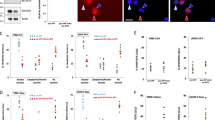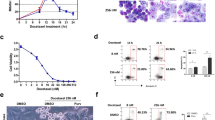Abstract
RB94, which lacks the N-terminal 112 amino-acid residues of the full-length retinoblastoma protein (RB110) is a more potent inhibitor of cancer cell growth than RB110, being cytotoxic to all cancer cell lines studied, independent of their genetic abnormalities. Although we initially thought RB94-induced cell death was caspase-dependent, such caspase activation now appears to be a late event. Cells that remained attached 48 h after transduction with Ad-RB94 showed, among other changes, nuclear enlargement, peripheral nuclear chromatin condensation and often micronucleation. In addition, the cells were TdT-mediated dUTP nick end labeling (TUNEL) positive but showed no cleavage of caspase 3 or 9. Only after the cells detached was cleavage of both caspase 3 and 9 observed. These TUNEL-positive cells showed neither cytochrome c mitochondrial translocation usually found in typical apoptotic cells nor DNA laddering indicative of oligonucleosomal DNA fragmentation. In addition, although 50 kb DNA fragmentation was produced in these TUNEL-positive cells, which was dependent on apoptosis-inducing factor (AIF), inhibiting this fragmentation by siAIF did not inhibit TUNEL formation or cytotoxicity. As RB94 will soon be used for gene therapy further understanding the molecular basis of these early changes in killing cancer cells is one of our particularly important present goals.
This is a preview of subscription content, access via your institution
Access options
Subscribe to this journal
Receive 12 print issues and online access
$259.00 per year
only $21.58 per issue
Buy this article
- Purchase on Springer Link
- Instant access to full article PDF
Prices may be subject to local taxes which are calculated during checkout





Similar content being viewed by others
Abbreviations
- Ad-RB110:
-
adenoviral-mediated RB110
- Ad-RB94:
-
adenoviral-mediated RB94
- AIF:
-
apoptosis-inducing factor
- Dox:
-
doxycycline
- FIGE:
-
field-inversion gel electrophoresis
- HMW:
-
high molecular weight
- kb:
-
kilobase
- MOI:
-
multiplicity of infection
- RB:
-
retinoblastoma
- RB110:
-
full-length wild-type RB protein of 110 kDa
- RB94:
-
RB protein of ∼94 kDa
References
Xu HJ, Xu K, Zhou Y, Li J, Benedict WF, Hu SX . Enhanced tumor cell growth suppression by an internal AUG codon initiated retinoblastoma protein. Proc Natl Acad Sci USA 1994; 91: 9837–9841.
Xu HJ, Zhou Y, Seigne J, Perng GS, Mixon M, Zhang C et al. Enhanced tumor suppressor gene therapy via replication-deficient adenovirus vectors expressing an N-terminal truncated retinoblastoma protein. Cancer Res 1996; 56: 2245–2249.
Zhang X, Multani AS, Zhou JH, Shay JW, McConkey D, Dong L et al. Adenoviral-mediated retinoblastoma 94 produces rapid telomere erosion, chromosomal crisis, and caspase-dependent apoptosis in bladder cancer and immortalized human urothelial cells but not in normal urothelial cells. Cancer Res 2003; 63: 760–765.
Pirollo K, Rait A, Zhou Q, Yu W, Hogrefe R, Chang EH et al. Tumor- targeting nanocomplex delivery of tumor suppressor RB94 enhances chemosensitization of bladder carcinoma cells in vitro and in vivo. Clin Cancer Res 2008; 14: 2190–2198.
Sabichi A, Keyhani A, Tanaka N, Delacerda J, Lee IL, Zou C et al. Characterization of a panel of cell lines derived from urothelial neoplasmas: genetic alterations, growth in vivo, and the relationship of adenoviral-mediated gene transfer to Coxsackie adenovirus receptor expression. J Urol 2006; 175: 1133–1137.
Chapman EJ, Hurst CD, Pitt E, Chambers P, Aveyard JS, Knowles MA . Expression of hTERT immortalises normal human urothelial cells without inactivation of the p16/Rb pathway. Oncogene 2006; 25: 5037–5045.
McConkey DJ . Calcium-dependent, interleukin 1beta-converting enzyme inhibitor-insensitive degradation of lamin B1 and DNA fragmentation in isolated thymocyte nuclei. J Biol Chem 1996; 271: 22398–22406.
Niikura Y, Dixit A, Scott R, Perkins G, Kitagawa K . BUB1 mediation of caspase-independent mitotic death determines cell fate. J Cell Biol 2007; 178: 283–296.
Susin SA, Lorenzo HK, Zamzami N, Marzo I, Snow BE, Brothers GM et al. Molecular characterization of mitochondrial apoptosis-inducing factor. Nature 1999; 397: 441–446.
Daugas E, Susin SA, Zamzami N, Ferri KF, Irinopoulou T, Larochette N et al. Mitochondrio-nuclear translocation of AIF in apoptosis and necrosis. FASEB J 2000; 14: 729–739.
Susin SA, Daugas E, Ravagnan L, Samejima K, Zamzami N, Loeffler M et al. Two distinct pathways leading to nuclear apoptosis. J Exp Med 2000; 192: 571–580.
Acknowledgements
This study was supported by Grant CA-097127 from the National Cancer Institute to WFB and a Career Development Award to JZ from The GU SPORE in Bladder Cancer CA-091846.
Author information
Authors and Affiliations
Corresponding author
Rights and permissions
About this article
Cite this article
Zhou, J., Zhang, XQ., Ashoori, F. et al. Early RB94-produced cytotoxicity in cancer cells is independent of caspase activation or 50 kb DNA fragmentation. Cancer Gene Ther 16, 13–19 (2009). https://doi.org/10.1038/cgt.2008.54
Received:
Accepted:
Published:
Issue Date:
DOI: https://doi.org/10.1038/cgt.2008.54
Keywords
This article is cited by
-
Effect of isolated grandivittin from Ferulago trifida Boiss. (Apiaceae) on the proliferation and apoptosis of human lung cancer A549 cells
Naunyn-Schmiedeberg's Archives of Pharmacology (2023)



